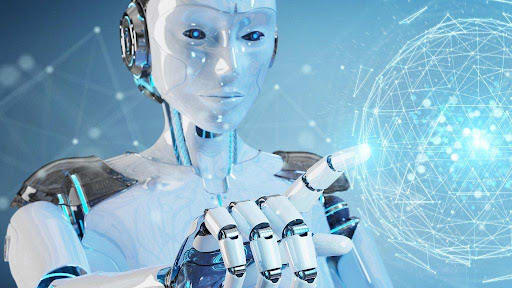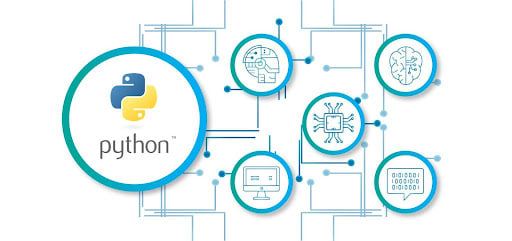Learn Python with Artificial Intelligence and Robotics
Summary
Thanks to robotics applications, learning new programming languages is now possible and straightforward. Python is a frequently used programming languages today. Python has become relatively simple to understand because of robotics applications. Artificial Intelligence and Robotics have been present for more than half a century, and their breakthroughs are increasing at a rapid pace. The need for Artificial Intelligence is at an all-time high, and if you're interested in learning more about AI and robotics, you've come to the perfect spot. Artificial Intelligence and Robotics are the topics of this blog. With Python, you'll be able to grasp all of the ideas of AI and robotics through actual Python implementations.
A. What is Artificial Intelligence and Robotics?
Image Source: entreprenuersdiaries
Artificial intelligence (AI) and Robotics are the IT industry's new dark. While debates regarding the safety of its growth continue, developers continue to expand artificial intelligence's capabilities and capability. Artificial Intelligence has progressed far beyond the realm of science fiction. It became a requirement. AI, which is commonly used for processing and analysing large amounts of data, aids in the handling of tasks that are no longer possible to complete manually due to their increased volume and intensity.
Artificial Intelligence (AI) has become a revolutionary term in the industry, and for a good reason. Artificial Intelligence, or AI, has progressed so far in the technological area that, according to a Gartner report, AI will create 2.3 million jobs by 2020, replacing the 1.8 million jobs it would displace.
Python is a frequently used programming language today. Python has become relatively simple to understand because of robotics applications. This language is ideal for creating a variety of apps. Despite the fact that there are many other languages to choose from, people choose Python for a variety of reasons. Python is a flexible and strong language when compared to other software and computer languages.
B. Why Is Python Best For Artificial Intelligence and Robotics?
Python also comes with a vast code library, making it a versatile tool for a variety of applications. Robotics is an example of one of these fields. The combination of robots with Python produces really successful work.
With the growing volume and complexity of data, AI and Robotics are now being employed to process and analyse it. To be fair, the human brain has the ability to analyse enormous volumes of data, but it is limited by the quantity of material it can take at any given time. Artificial Intelligence is not bound by this constraint. AI-assisted forecasts and insights improve company efficiency, reduce production costs, and boost productivity. It's no surprise that AI and Robotics are being used by numerous sectors to boost performance and accelerate product development.
The industrial robots market is estimated to be worth $80 billion. The majority of robotics advancements are attributable to advancements in the artificial intelligence (AI) industry. In the robotics field, artificial intelligence aids in the control of robots. Python is a widely-used programming language due to its ease of use and flexibility.
C. Why has Python gained so much popularity in all these fields?
Source: quintagroup
Following are some of the major reasons why Python is the first choice of language for any core software developer or data scientist, or machine learning engineer or any other:
Less Code: Implementation of Artificial Intelligence is a necessity for a larger number of functionalities. Thanks to Python's pre-defined packages, we don't have to code all the algorithms. To make things easier, Python has a "check as you code" methodology that decreases the amount of time spent testing the code.
Prebuilt Libraries: Python has a large number of pre-built libraries which helps in implementing Artificial Intelligence and Robotics functionalities. So, each time you want to run an algorithm on a data set, all you have to do is write and run a single line code to install and load the appropriate packages. NumPy, Tensorflow, Pytorch, Keras and other pre-built libraries are examples.
Ease of learning: Python has a fairly basic syntax that can be used to implement simple computations like adding two strings to more sophisticated procedures like developing a Machine Learning model.
Platform Independent: Python can operate on a variety of platforms, including Windows, macOS, Linux, Unix, and others. You can use tools like PyInstaller to take care of any dependency concerns while migrating code from one platform to another.
Huge User Community: Python has a large user community that is always willing to help when we run into coding issues. Python offers various communities, groups, and forums where programmers can discuss their issues and support one another, in addition to a large fan base.
D. Robotics and Artificial Intelligence Libraries in Python
Because this blog is about Python for Artificial Intelligence and Robotics, I'll show you some of the most useful and popular Artificial Intelligence-based Python libraries.
Tensorflow: It is a Google-developed library is widely utilised in the development of Machine Learning algorithms and the execution of complex calculations involving Neural Networks.
Scikit-Learn: Scikit-learn is a NumPy and SciPy-related Python package. It is considered one of the best libraries for dealing with large amounts of data.
Numpy: Numpy is a Python module that is used to compute scientific and mathematical data.
Theano: Theano is a functional library that efficiently calculates and computes multi-dimensional array mathematical expressions.
Keras: This library makes it easier to build neural networks. It also provides the best features for constructing models, assessing data sets, displaying graphs, and many other things.
NLTK: NLTK (Natural Language Toolkit): Kit is a Python library for Natural Language Processing, text analysis, and text mining that is a free source.
Python is compatible with robotic operating systems. Python has computational libraries that are necessary for the robotics area. Python Remote Objects (Pyro), for example, is a library for creating applications in which objects can communicate with one another over the internet. Pybotics is a Python toolbox for robot kinematics and calibration that is open-source. Pyrobotics was created with the goal of providing a simple, clear, and compact interface for quickly simulating and evaluating various robot concepts, including kinematics, dynamics, and calibration. PyRobot is a Python toolkit for comparing and running robot learning experiments. It's suitable for applications that don't have APIs. We can now run robots without having to deal with robot-specific software, thanks to this library. Python's robotic libraries are really handy. Even simply for this vast library pool, Python can be taught.
E. Demand For Robotics and Artificial Intelligence
Since AI was invented in the 1950s, we've seen an exponential increase in the potential of Artificial Intelligence. But, the question is why has AI suddenly become so important? Why are we discussing Artificial Intelligence and Robotics right now?
The following are the primary reasons behind AI and Robotics enormous popularity:
More computational power: Building AI and Robotics models includes important calculations and the implementation of complex neural networks, which requires a lot of computing power. This led to the invention of GPUs.
Data Production: Over the last years, we've produced a lot of data. Machine Learning algorithms, other Robotics and AI approaches must be used to examine and process such data.
Broad Investment: As tech titans such as Tesla, Netflix, and Facebook began to invest in Artificial Intelligence and Robotics, the technology grew in prominence, resulting in a rise in demand for AI and Robotics-based solutions.
Artificial Intelligence and Robotics are growing at an exponential rate, and it is contributing to the economy at a rapid rate. As a result, now is an excellent time for you to enter the field of Artificial Intelligence.
F. Job Profiles after learning Python with Artificial Intelligence and Robotics
According to Indeed, the demand for AI and Robotics capabilities has more than doubled in the last three years, with a 119 per cent increase in job posts. Without the many Job Profiles, this Artificial Intelligence and Robotics with Python blog would be incomplete. So, if Artificial Intelligence and Robotics fascinate you and you want to work in the sector, below are the various Job Profiles you can apply for if you have AI and Robotics skills.
- Machine Learning Engineer
- Big Data Engineer/Architect
- Artificial Intelligence Engineer
- Research Scientist
- Business Intelligence Developer
Data Scientist
Conclusion
Artificial Intelligence (AI) and Robotics are techniques that allow machines to replicate human behaviour. Artificial intelligence (AI) and Robotics is the study and development of computer systems that can do activities that would ordinarily require human intelligence, such as vision, speech recognition, decision-making, and language translation. You can learn all about how to implement Artificial Intelligence (AI) and Robotics with Python from various free python online courses on different platforms.
Original Link: https://dev.to/sumedhalv/learn-python-with-artificial-intelligence-and-robotics-101e
Dev To
 An online community for sharing and discovering great ideas, having debates, and making friends
An online community for sharing and discovering great ideas, having debates, and making friendsMore About this Source Visit Dev To

